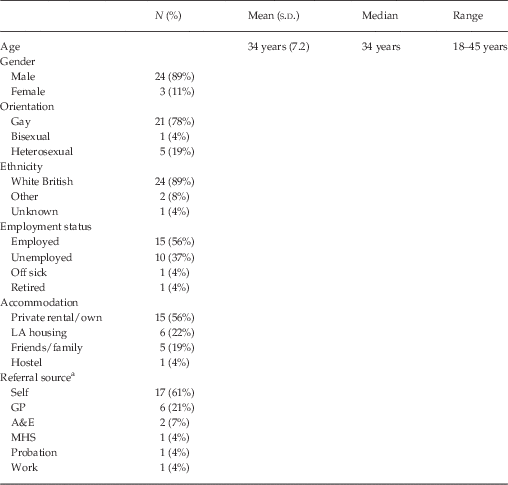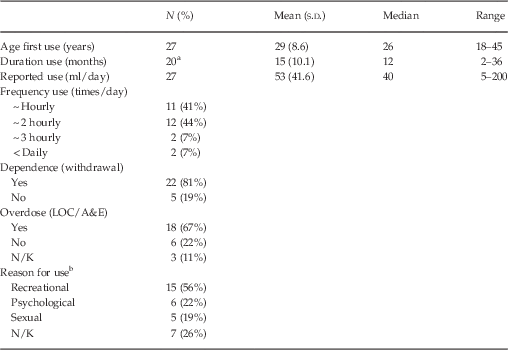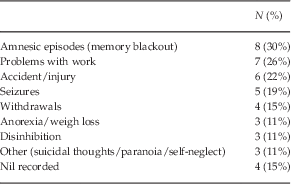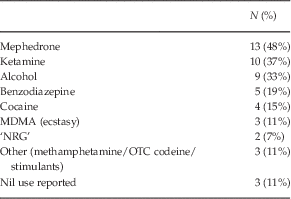Introduction
Gamma-butyrolactone (GBL, known colloquially as ‘G’) is a common industrial solvent used in floor strippers, paint thinners, nail varnish removers, etc. In humans, GBL is rapidly absorbed when ingested and converted to gamma-hydroxybutyrate (GHB). GHB occurs naturally in the central nervous system and is thought to be a neurotransmitter. GHB is a GABA b agonist whose functions appear to be closely linked to the GABA system (Gonzalez & Nutt Reference Gonzalez and Nutt2005); 1 ml of pure GBL is equivalent to 2.5 g GHB.
Reports of GBL/GHB and related analogues as drugs of misuse emerged during the 1990s, often via Emergency Departments (ED) (Ryan & Stell Reference Ryan and Stell1997; Williams et al. Reference Williams, Taylor and Roberts1998a). Both also gained notoriety as ‘date-rape’ drugs, while GHB was marketed as a growth hormone stimulant used by body builders (Galloway et al. Reference Galloway, Frederick-Osbourne, Seymour, Contini and Smith2000). More recently the use of GBL has become popular in the ‘club scene’ (Bowden-Jones Reference Bowden-Jones2013) and has also been linked with high-risk sexual practices and the ‘gay scene’ (Kirby & Thornber-Dunwell Reference Kirby and Thornber-Dunwell2013). GBL and GHB are both Class C drugs – GBL is available for legitimate use in industry, it is an offence, however, to supply knowing or believing that it will be swallowed or ingested. Most GBL is sold in the ‘grey market’ often as ‘alloy cleaner’ or ‘rust remover’ and it is widely available on line.
Desired effects of GBL/GHB include a feeling of euphoria, wellbeing and disinhibition not unlike the effects of alcohol. Adverse complications include nausea, vomiting, ataxia, muscle stiffness, twitching, confusion, convulsions, overdose and coma. The effects are dose dependent with a steep dose–response curve (Gonzalez & Nutt Reference Gonzalez and Nutt2005). The first GBL-related death in the United Kingdom occurred in 2009 (Dargan et al. Reference Dargan, Button, Davis, Ramsey, George, Holt and Wood2009).
After a time lapse of approximately a decade, reports of dependence together with a description of a well-recognized withdrawal syndrome began to appear (McDonough et al. Reference McDonough, Kennedy, Glasper and Bearn2004; Gonzalez & Nutt Reference Gonzalez and Nutt2005). GBL/GHB withdrawal appears similar to alcohol withdrawal; however, it is more sudden in onset, more severe in its manifestations and is longer in duration. Withdrawal symptoms include nausea, vomiting, anxiety, sweating, craving and insomnia. More severe withdrawal can progress to auditory and visual hallucinations, agitation, tremor and delirium not dissimilar to alcoholic delirium tremens (McDonough et al. Reference McDonough, Kennedy, Glasper and Bearn2004; Gonzalez & Nutt Reference Gonzalez and Nutt2005).
The present study expands on the literature and aims to describe the patient profile, pattern of use, related problems and comorbidity of a cohort of patients presenting to the Substance Misuse Service in Brighton and Hove City.
Method
The study was a retrospective clinical case-note review of patients presenting to the Substance Misuse Service in Brighton and Hove City. A combination of clinical case-notes and electronic patient database were screened to identify patients with GBL/GHB as their primary drug of misuse. A review of relevant case-notes was undertaken and relevant information was systematically extracted from routinely collected clinical data using a semi-structured study questionnaire. All subjects had been clinically reviewed by one or both of the authors (G.A. and H.W.).
There were 27 individual patient presentations between 2008 and 2013. However, two-thirds (18, 66%) of the subjects presented between January 2012 and June 2013 representing a rate of one new case per month. For individuals with more than one presentation, only the initial index episode was included in data analysis.
All data were confidential, anonymized and with no individual patient being identified. Only pooled patient data (as opposed to individual case reports) is presented. Approval to undertake the study as a clinical audit was received from the Sussex Partnership NHS Foundation Trust’s Research & Development Department.
Results
Of the subjects studied, 24 were male (89%) and 3 were female (11%). The mean age of study population was 34 years (s.d.=7.2) and ranged 18–45 years. In all, 24 (89%) were white British, 2 (8%) ethnicity was other and 1 (4%) ethnicity was unknown. A total of 21 (78%) identified themselves as being gay, 5 (19%) heterosexual and in the case of 1 female (4%) bisexual. In all, 15 (56%) were in full-time employment or third-level education, 10 (37%) were unemployed, while 1 (4%) was off sick and 1 (4%) was retired. In all, 15 (56%) were living in rented or owned their own accommodation, 6 (22%) were in local authority housing, 5 (19%) were living with friends or family and 1 (4%) was in hostel accommodation. In all, 17 (61%) were self-referrals, 6 (21%) were referred by their general practitioner (GP), 2 (7%) from EDs, with 1 (1, 4%) each by work, mental health services and probation services (Table 1).
Table 1 Socio-demographic details of GBL/GHB users (N=27)

GBL, gamma-butyrolactone; GHB, gamma-hydroxybutyrate.
a >1 referral.
The mean age of first-ever use of GBL/GHB was 29 years (s.d.=8.7) with a range 18–45 years. The mean duration of use of GBL/GHB before the first presentation was 15 months (s.d.=10.1) with a range 2 months to 3 years. Data on duration of use were missing in the case of seven (26%) individuals. The mean amount of GBL/GHB used per day was 53 ml (s.d.=46.1). The median amount was 40 ml and range varied greatly between 5 and 200 ml daily. With regard to frequency of use 11 (41%) reported using approximately hourly, 12 (44%) 2 hourly and 2 (7%) 3 hourly. Only two patients (7%) reported using on a less than daily basis, both using GBL/GHB 2–3 days/week (Table 2).
Table 2 Clinical details of GBL/GHB use (N=27)

GBL, gamma-butyrolactone; GHB, gamma-hydroxybutyrate; N/K, not known.
a Missing data.
b >1 reason.
In all, 22 (81%) of the individuals were deemed to be physically dependent on GBL/GHB (operationally defined as experiencing withdrawal features). In all, 18 (67%) reported having ever experienced a GBL/GHB overdose (operationally defined as an episode of loss of consciousness and/or being transported to ED); 6 (22%) denied ever having a GBL/GHB-related overdose and data were missing in the case of 3 individuals (11%). A total of 8 (39%) individuals reported more than one GBL/GHB overdose, however, data on the number of overdoses were missing for 14 (52%) cases. With regard to reasons for GBL/GHB use; 15 (56%) individuals stated recreational use (e.g. at clubs, party scene), 6 (22%) for psychological reasons, 5 (19%) in a sexual context (namely to facilitate sex-work (3, 11%) and at sex parties (2, 7%)). The reason(s) was not stated for seven (26%) cases (Table 3).
Table 3 Self-reported problems with GBL/GHB use (N=27)

GBL, gamma-butyrolactone; GHB, gamma-hydroxybutyrate.
Other complications related to GBL/GHB were reported by 24 (89%) individuals and included: amnesic episodes (memory blackouts) eight (30%), accidents/injuries six (22%), problems at work seven (26%), seizures five (19%), withdrawal complications four (15%), anorexia/weight loss three (11%), disinhibition/risky behaviours three (11%), suicidal thoughts one (4%), paranoia one (4%) and self-neglect one (4%). In the case of four (15%) patients no associated problems were recorded. Concurrent use of other substances was reported by 24 (89%) of the individuals and included mephedrone use by 13 (48%) individuals, ketamine by 10 (37%), alcohol by 9 (33%), benzodiazepines by 5 (19%), cocaine by 4 (15%), MDMA by 3 (11%), ‘NRG’ by 2 (7%), methamphetamine by 1 (4%), OTC codeine by 1 (4%) and ‘a stimulant’ by 1 (4%). A total of three individuals (11%) denied concurrent substance use (Table 4).
Table 4 Concurrent substance use and GBL/GHB (N=27)

GBL, gamma-butyrolactone; GHB, gamma-hydroxybutyrate.
The mean General Anxiety Disorder seven-item scale (GAD-7) score was 15 (s.d.=5.2), median 16 with a range of 1–21. In all, 24 (89%) scored greater than 10 (the cut-off point for the GAD). Of the patients studied, 10 (37%) had a diagnosis of HIV of which all had contact with HIV/GUM services. At the time of presentation, seven (70%) were in receipt of antiviral medication, two patients were due to commence medication (when substance use was managed) and one (10%) was not on treatment. With regard to the proposed clinical treatment plan at time of presentation: 15 (56%) patients were referred for in-patient treatment, 8 (30%) for community treatment and 4 (15%) a combination of in-patient followed by community treatment. No immediate medical intervention (namely medication-assisted detoxification) was deemed necessary in the case of two individuals.
Discussion
The majority of our patients were white British males (90%) with four out of five identifying themselves as being from the lesbian, gay, bisexual and transgender (LGBT) community. This finding may reflect the previously described association of GBL/GHB use and the gay community (Beddoes et al. Reference Beddoes, Sheikh, Khanna and Francis2010; National Treatment Agency for Substance Misuse 2012). Of the population of Brighton and Hove City (~0.25 million) 15% are from the LGBT community.
Just over half of our study sample reported being in full-time employment or in third-level education (56%) and having stable accommodation (56%). This degree of social stability has been reported in other studies of GBL/GHB use. For example, Miotto et al. (Reference Miotto, Darakjian, Basch, Murray, Zogg and Rawson2001) in the USA and Degenhardt et al. (Reference Degenhardt, Darke and Dillon2002) have alluded to the phenomenon of ‘little or absent social decline as typically observed in cases of other addictions’, for example, opiates. Despite this relative social stability, there was nevertheless a high level of physical and psychological comorbidity in our study population.
Our study sample had a late age of first use of GBL/GHB (mean 29 years) and a short duration (median 12 months) of use before presentation for treatment. In addition, our subjects were using GBL in relatively large amounts (mean 53 ml/day), most (90%) on a daily basis compared with reports on less problematic, non-treatment samples (Degenhardt et al. Reference Degenhardt, Darke and Dillon2003). Therefore, not surprisingly there was a high incidence (81%) of physical dependence (operationally defined as experiencing withdrawal). Indeed the risk of dependence and severe withdrawal may be more likely with greater than 3 months’ duration of daily use, use of >20–30 mg of GBL daily and particularly ‘around the clock’ (namely every few hours) use of GBL (Miotto et al. Reference Miotto, Darakjian, Basch, Murray, Zogg and Rawson2001; McDonough et al. Reference McDonough, Kennedy, Glasper and Bearn2004; Gonzalez & Nutt Reference Gonzalez and Nutt2005). Our sample may therefore represent the more severe end of the use – harmful use – dependence clinical spectrum.
GBL/GHB overdose was reported in almost two-thirds of our sample with at least eight individuals (30%) having had more than one episode. Likewise, Degenhardt et al. (Reference Degenhardt, Darke and Dillon2003) found that overdose was common, with 53% of their sample experiencing overdose increasing to 75% in those who had used GBL/GHB on more than 15 occasions. This may reflect the drug’s rather steep dose–response curve. Profound unconsciousness in the context of GBL/GHB use is, however, often followed by a full and rapid recovery, especially when managed in a medical setting (Williams et al. Reference Williams, Taylor and Roberts1998a; Bell & Collins Reference Bell and Collins2011).
In keeping with other reports, particularly from EDs (Ryan & Stell Reference Ryan and Stell1997; Williams et al. Reference Williams, Dratcu, Taylor, Roberts and Oyefeso1998b; Bell & Collins Reference Bell and Collins2011) GBL/GHB use did not occur in isolation; only 3 of our 27 subjects denying concurrent use of other substances. The clinical picture may therefore be complicated by coingestion making it difficult to attribute clinical features to one substance. McDonough et al. (Reference McDonough, Kennedy, Glasper and Bearn2004), in their review of published reports commented that coingestion of other drugs (namely alcohol, barbiturates, benzodiazepines, opiates and amphetamines) was not associated with more severe GBL/GHB withdrawal.
All individuals completed the GAD-7, a commonly used screening tool for anxiety disorders in primary care (Kroenke et al. Reference Kroenke, Spitzer, Williams, Monahan and Lowe2007) although its validity in substance use populations is yet to be established. Psychiatric comorbidity, especially anxiety symptoms was particularly common with 24 out of 27 (89%) cases scoring above the tool’s cut-off point. In addition, 14 individuals (52%) had received treatment for anxiety (e.g. by GP, psychiatrist, etc.). Anecdotally, the authors have noted that anxiety symptoms are common and can persist long after detoxification in this patient group. Whether this is an emergence of pre-existing conditions or perhaps a prolonged residual withdrawal effect requires further elucidation.
A number of limitations to the present study deserve comment. GBL/GHB ingestion was based on patients’ self report as at present there is no routinely available toxicology analysis for GBL/GHB. Nevertheless, patients’ descriptions were highly consistent with what is known of the drug’s effects. Our sample size was modest, was limited to those reporting GHB/GBL as their primary drug of use, who gave a history suggestive of heavy dependent use and who were seeking treatment. The study findings may therefore represent an underestimate of actual extent of use and complications of GBL/GHB in Brighton and Hove City.
EDs provide a unique opportunity to describe new drugs of misuse, and to monitor, manage and refer related problems (Williams et al. Reference Williams, Dratcu, Taylor, Roberts and Oyefeso1998b). Given the high incidence of overdose and other complications reported in the present study it is surprising that more referrals did not come from this potentially fertile source. Likewise, over a third of our patients were HIV positive yet none had been referred directly by HIV services. There may be potential for closer liaison between HIV and Substance Misuse Services with, for example, improved awareness, early identification and referral of GBL/GHB users together with facilitation of better compliance with antiviral medications for patients undergoing GBL/GHB treatments.
With regard to medical management only data on the proposed treatment plans were recorded. Description of treatment outcomes, complications, disposal, follow-up, etc. were beyond the scope of the present study. A number of commentators have suggested that GBL/GHB dependence ‘requires vigorous clinical management’ in an in-patient setting (McDonough et al. Reference McDonough, Kennedy, Glasper and Bearn2004, Gonzalez & Nutt Reference Gonzalez and Nutt2005). Alternately, Bell & Collins (Reference Bell and Collins2011) have described a feasible community-based (albeit with seamless links to in-patient facilities) treatment model. The majority of our patients were referred for in-patient detoxification (using high dose benzodiazepines) with a smaller number (predominately those declining hospitalization), referred for management in the community. The clinical challenge for services for the future is to establish criteria that might help distinguish patients with GBL/GHB dependence who could benefit from community-based management from those requiring more intensive in-patient treatment. The impact by this small but growing group of patients on services has not been formally investigated, but given our sample’s unique socio-demographic profile and the high level of comorbidity is there a need for separate (from existing addiction services) and integrated specialist (community and in-patient) services?
Acknowledgements
The authors wish to thank Mrs Carol Welfare and Ms Amy Dunn for their valuable contribution, and Dr Anthony Glasper for helpful comments on earlier drafts of the manuscript.
Conflicts of Interest
None.






